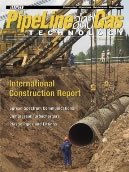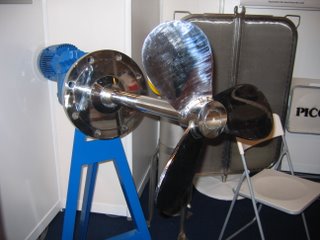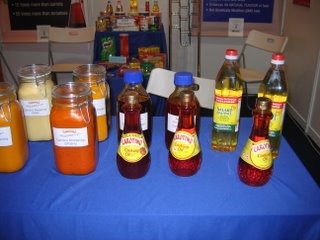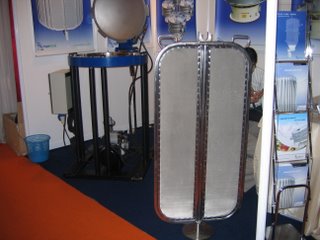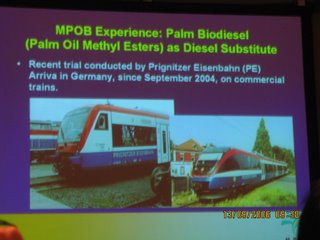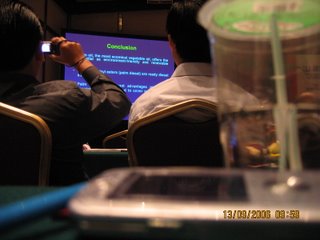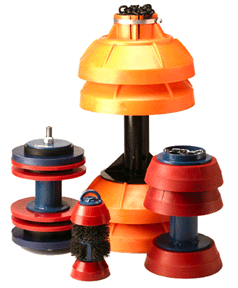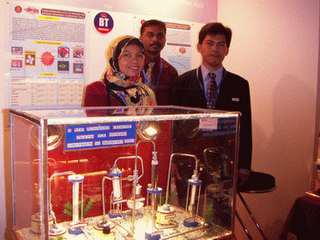E&P Daily News SPE Edition Day 2
(E&P : Exploration & Production)
Dear Colleague:
We hope you enjoyed yesterday's preview issue of the E&P show daily, as part of
the 2006 SPE Conference.
In case you are unable to attend the show, and as an advance look for those in
attendance, we have made today's issue available for your reading enjoyment.
Just click on this link to retreive it:
http://www.eandpnet.com/pdf/SPE%20Tuesday.pdf
Please accept it with our compliments.
Sincerely,
Russell Laas
Publisher
E&P Magazine
posted by Kipas Repair JB @ 8:57 PM,
,
![]()
Global LNG Outlook 2006
For you guys who are interested and perhaps live nearby or have some budget...
Don't miss out on this year's Global LNG Outlook 2006. Online registration closes at midnight on Monday, October 3rd and seats are going fast. This year's Global LNG Outlook 2006 will be held October 4-5, 2006, at the JW Marriott in New Orleans, LA.
Click here to see the current agenda and register.
If you don't have the opportunity to visit us online, onsite registration will open at 8:00 AM at the JW Marriott in New Orleans on Wednesday morning.
I look forward to seeing you at the conference.
Sincerely,
Bill Anderson
Director of Conferences and Events
Hart Energy Publishing
www.hartenergyconferences.com
posted by Kipas Repair JB @ 8:18 PM,
,
![]()
COST CUTTING JUSTIFICATION!
In any chemical industry and other industries, we cannot avoid from purchasing equipment or service which we need in order to perform our work in order to achieve our company objective/target. Whether we are working in a research institution or service company or chemical plant or etc...We need to purchase something as asset(s) or consumable(s) or service(s).
As engineers/executive/managers, we need to make wise and technical decision based on wise justification before deciding to purchase something. We need to consider the economical aspect and the Return on Investment (ROI) as well.
However, from my humble experience, we usually know what we want and how the product/service works. We are also capable to evaluate and justify the product/service which best suite our demand and requirement.
However, the problem arises when our superior/procurement department will question us and try to get the cheapest product/service without having better comprehension of what is exactly our requirement. Often, they'll overwrite our demand and honour us with cheaper product/service that they manage to get. Their concept and philosophy is most of the time COST CUTTING!!! They do not want to compromise on the quality and safety aspects!!!
The following is an excellent article that i read from Engineer Live regarding the COST of COST CUTTING by Steve Hayward from Delta International. I really recommend you reading it...
Buy cheap, pay dear. Driving down costs can be expensive
Steve Hayward this discusses the potential risks and detrimental effects involved in cutting costs.
There is a well known saying which states: “Buy cheap, pay dear”. An equally common expression is: “If you pay peanuts, you get monkeys”. The French say: “On a rien sans rien.” (You cannot get something for nothing) while the Spanish equivalent is “quien algo quiere, algo le cuesta”.
You start to realise that we all pretty much agree the world over that if you cut corners on price there is a very good chance you will pay for it later. So why have we become obsessed with driving costs down irrespective of whether this actually has a detrimental effect upon us and our objectives?
Read the rest from the link…
http://www.engineerlive.com/power-engineer/opinion/16349/buy-cheap-pay-dear-driving-down-costs-can-be-expensive.thtml
posted by Kipas Repair JB @ 12:08 AM,
,
![]()
SCADA and Communications
People new to the industry often use the terms SCADA (Supervisory control and data acquisition) and DCS (Distributed Control System) interchangeably. Although there's no sharp line separating these two categories of control systems, and specific implementations often have characteristics of each, it is useful to distinguish between them because of their unique strength and weaknesess.
The most significant factor differentiating SCADA system and DCS today is the "human in the loop". Well, enough about those explanation. It can be more technical and quite difficult to absorb for some people who are not really familiar with both control system.
To makes thing simpler and easier to understand what are SCADA and DCS, lets see their characteristics:
SCADA System
1. Geographic span: Large
2. Point count : Large
3. Data acquisition rates : Moderate - seconds to minute
4. Data acquisition network : Slow with moderate error rate
5. Graphic User Interfase (GUI) : Full featured
6. Alarming subsystem : Full featured
7. Control actions : Human initiated
DCS System
1. Geographic span : Small
2. Point count : Small
3. Data acquisition rates : Very fast - miliseconds to seconds
4. Data acquisition network : Fast with low error rate
5. Graphic User Interfase (GUI) : Basic
6. Alarming subsystem : Basic
7. Control actions : Programmatically initiated
Perhaps, later I'll slowly explain about these type of control systems...We must know and appreciate these system as it smoothen our process control and operation. These control system are applied in the oil & gas as well as in refineries too serving the oils and fats industries.
posted by Kipas Repair JB @ 9:42 PM,
,
![]()
Heat Exchanger Cleaning & Maintenance - GASKETs
Continuation from previous post...
You can either dismantle all the plate and frame heat exchanger OR you do the chemical cleaning. Well, i can say the decision must be correct. You must decide which method to chose.
If you decide to dismantle the heat exchanger, this will give you the highest cost impact. Why? This is because, when you dismantle the plate & frame heat exchanger, the gaskets in between the plates cannot be used anymore. Once the heat exchanger is opened, it can't be used again. The polymer structure of the gasket has already be distorted and is not in a prefect condition to be used again. By the time you open the heat exchanger, some of the gasket, might also be damaged too. Some of them have became very thin. Some of them have been torn. There are many types of condition. And most of the time, oil leaks in the heat exchanger is due to the gasket problem or the operator/technician did not fix the gasket properly on plate heat exchanger.
One set of gasket to be placed in between two plates is very expansive. Depending on what type of heat exchanger, type of plates, type of oils/fluids flowing, and also range of operating temperature. This information can be obtain from a gasket or heat exchanger supplier/manufacturer. So, imagine if the plate and frame heat exchanger have 220 plates, you must have 221 gaskets placed in between the plates and the two stainless steel frames on both ends.
posted by Kipas Repair JB @ 7:50 PM,
,
![]()
Learning Centre
I'd heard about the Spirax Sarco learning centre a couple of month ago. It's a very interesting site. There are tonnes of information inside it. You can learn about energy, steam engineering principle, heat transfer, boiler and much-much more. There are a lot to learn!!! And the informations are given free. See the Spirax Sarco Learning Centre HERE
posted by Kipas Repair JB @ 12:16 AM,
,
![]()
Centralized Control Room
I was given a new responsibility by my superior few months ago. As a chemical engineer, i felt this task a very chalenging but enriching! I don't have any background on how this thing work! I was given the task of developing Centralized Control Room (CCR). I have to learn a new stuff that I don't really know. I have to know all the new terms and meaning of all short phrases and wording. I have to learn the control system of all the control system in all plants. It's a very interesting project to handle. As there's not much physical object to be seen or touch. Perhaps some cable/fibre optic/PC etc. Need to understand some network architecture too...
Well, there's something in Siemen product and learning centre about the CCR info. Siemen have a wide range of product for a very good and efficient way of control and planing in a plant/factory. You can visit and learn some stuff there....I'm also in the learning process too...visit the HERE
Learn about Siemen Simatic IT Manufacturing Execution System (MES) HERE
posted by Kipas Repair JB @ 5:17 PM,
,
![]()
Some Engineering Joke...Stupidity!!!
posted by Kipas Repair JB @ 10:27 PM,
,
![]()
Used Vegetable Oil to Biodiesel Dilemma
My biodiesel knowledge came into picture just recently. Although I knew this subject has been very hot for the past few years, only now, suddenly I felt the adrenalin to learn more about it.
I knew that biodiesel has already shown some success in US and Europe, both using soy bean and rape seed oil respectively. That's a good sign of our world energy sector. A number of biodiesel plants have been built in the past 5 years, and the number is still growing.
However, what interest me most is the simplicity of converting used cooking oil to methyl ester (Biodiesel). Well, the process seems very simple. I have seen some people easily convert used cooking oil to biodiesel in just one night!! But that's in US and Europe!!! Few days ago, I did have a chat with my wife about this process. I mean about the process of used cooking oil conversion to biodiesel B100. It's actually a very brilliant process. However, i did mention to her about my concern of the feasibility of used cooking palm oil based which is mostly found in my country and surrounding countries. Yes, the process might work for used cooking oil originated from soy and rape seed oil, but how about the one from palm oil?
I was just informed that somebody have tried to convert used cooking palm oil based and failed to get diesel! This really caught my interest as I was just about the accumulate some used cooking oil from my kitchen! Well, i still do not have the details of that particular process, but I'm definitely going to get some details about it. My guess is, some modification in the process need to be done. But what modification? I don't know yet. I need to carry out some kitchen scale experiment in order to have better comprehension on the process. Maybe this palm oil based used cooking oil have some different molecular structure or transfatty acid property which would not easily react and produce biodiesel.
Anybody have any experience or knowledge about this? maybe we can share something...
posted by Kipas Repair JB @ 8:24 PM,
,
![]()
Heat Exchanger Cleaning
You have a plate and frame heat exchanger in your plant. The heat exchanger have been in operation for perhaps one year already. By this time, the efficiency have dropped. The heat exchanger cannot provide you the desired output temperature when they heat exchange.
How do you know this? You can know by seing the output temperature of both fluid ie the cold fuild and the hot fluid. If the output cold fluid temperature has increased and the output hot fluid temperature has decreased, then this are the sign of some sort of inefficient heat exchange situation. Why is this happening?
You can also check the pressure of the input hot or cold fluid, ie if the pressure increased, it is a sign of something called "fauling" which resulted in the heat exchange becoming inefficient. Yes, fauling is one thing that most of the time caused the heat exchanger to be not working optimumly.
All of these are just part of what you can notice and experience on your plate and frame heat exchanger. When this happen, you might want to consider removed the fauling from the plates.
But how? You have to options. You can either dismantle all the plate and frame heat exchanger OR you do the chemical cleaning. Well, i can say the decision must be correct. You must decide which method to chose. Because both will have direct impact on your production and/or operation and/or maintenance cost. So, you don't want to be caught making a bad decision by your superior!!! Ok. Let's continue in the next post....got more to tell....
posted by Kipas Repair JB @ 9:46 PM,
,
![]()
My Cooling Tower Encounter...
I've heard about cooling tower when i was doing my chemical engineering degree long before. That time, i hardly know what exactly a cooling tower is. Though the principal of cooling tower is mention inside all unit operation book, i did not really look at it. I did not realise how important a cooling tower is until i work as a process engineer in a plant.
That time, then i realised how serius a cooling tower is for a any plant. My first learning point about the cooling tower is not about the cooling tower. It is rather about the water treatment chemicals of the cooling tower. Later on, i learn more and more...and it's not just about providing enough cool water to the plant, but more than that. I was given the responsibility to handle and take care of the cooling tower. Well, I'm not really good at it, but i did get a lot of help from people around me who have been handling the cooling tower and also other imperative aspects of the plant.
I did work together with a colleague of mine to set up a sand filter for a cooling tower. Not, only that, the cooling tower that i took care was having a lot of water quality problem. So, it took me several months to study and detect to eliminate the problems. Hopefully the problem is no longer there now....Also, the other maintenance part of the cooling tower....Oh....that's a lot to talk about a single simple cooling tower....
I'll share some experience of handling the cooling tower. This is good especially for chemical engineering student and the one who are preparing themself to work. You can learn and know better about what a cooling tower is all about. I hope my post, any articles posted, any links regarding the cooling tower can provide better comprehension for you....
posted by Kipas Repair JB @ 7:45 PM,
,
![]()
Biodiesel Future Questionmark???
- Is B5 Biodiesel the world future biodiesel?
- Is marine algae another source for biodiesel?
- Biodiesel future lies on the power of politician? or technologist/scientist?
- Which one is going to be a HIT in the next 10 - 20 years, Biodiesel or Gas to Liquid (GTL)?
- Can u capitalize from the emergence of biodiesel?
posted by Kipas Repair JB @ 8:39 PM,
,
![]()
My first Heat Exchanger Encounter....
It was in my third working place that i learn and have better comprehension about the heat exchanger. There are various types of heat exchanger in plant. We have plate and frame heat exchangers, shell and tube, spiral cooler and others.
The first time i get to know a plate and frame heat exchanger was when i was instructed by my boss to supervise a group of technicians and contract worker fixing and installing about 233 plates onto a heat exchanger frame. It was not an easy job. The task was very physically demanding.
Plate & Frame Heat Exchanger - Hot fluids flow down between alternate plates, cold fluids flow up between alternate plates (Adopted from Perrys Chemical Engineering Handbook: Thermal division Alfa LAval, Inc)
While performing this task, we have to be careful of the plates arrangement. We have to be carefull of the numbers and quantity of the plates. I have witness one time, these people accidently missed out one plate, which can result in the 2 types of oil cannot pass through. Thus, upsetting the initial intention of heat transfer. As soon as they realised that they miss out one plate, they decide to put another extra plate in between to continue the path of the two oils not to be blocked. Well, that's ok. But, they need to be carefull next time. Not to be careless and repeat the same mistake.
The technique to tightened the plate and frame heat exchanger must be correct. We must tighten it in a criss cross manner and in the same time take the measurements of all the bolt length. The tightening length must be the same for all 8 bolts (if there is 8 bolts).
There are still a lot more to tell about the hidden information of heat exchanger.....i mean the type of information and knowledge that is not written in the text book. The one that we can only know and get it from experience and other peoples experience. I'll share some of my experience of dealing with heat exchanger from time to time. I sincerely hope the information will be beneficial for those who want to learn and know more about heat exchangers, heat transfer.
posted by Kipas Repair JB @ 8:15 PM,
,
![]()
Offering You Your Own Subscription
Why share your copy - when they can get their own? Tell your colleagues to start their own FREE Subscription.
— Does your copy of PipeLine and Gas Technology look like it's traveled thru an oil and gas pipeline on its way to your desk?
— Do you find yourself retrieving your latest copy from a colleague's desk?
— Or... perhaps you'd like to promote yourself off the bottom of the routing list -- to the top that is?
The answer is simple... get your own... or, better yet, have your colleagues get their own subscription to PipeLine and Gas Technology.
Click here and get your free copy >>> http://www.submag.com/sub/pb?pk=E69PPA
We know each and every issue of PipeLine and Gas Technology contains crucial, cutting-edge reporting of the solutions, applications and technolgies being employed in the pipeline industry. And, we know ALL your colleagues would benefit from PipeLine's uniquely styled, how-to approach to discussing the issues you and other pipeline professionals face every day.
But... did you know that PipeLine and Gas Technology is offered free of charge to all pipeline industry professionals?
That means ALL your colleagues can have their very own subscription. That's right... all your colleagues. So... if you or someone in your office would benefit from receiving PipeLine and Gas Technology for themselves, simply, forward this email and ask them to click the link below. It will only take a few minutes and, you won't ever have to track down your copy again.
Click here and get your free copy >>>http://www.submag.com/sub/pb?pk=E69PPA
Get more details >>>> www.pipelineandgastechnology.com
You can also get the online version by visiting the above website.
posted by Kipas Repair JB @ 5:04 PM,
,
![]()
ANOUNCING A HOT BUT GREEN EVENT
Ethanol & Biofuels Asia 2006: 1 - 3 November 2006, Suntec, Singapore 

The event that will bring together all stakeholders from the entire Biofuels value chain - regulators, biofuel producers, feedstock providers, technology providers, project consultants, industrial end-users and investors
The only green energy conference in Asia that explores the fundamentals of ethanol and biofuels from a legislative, supply & demand and investment perspective
Held in conjunction with Global Entrepolis @ Singapore, a major event that will bring together over 14,000 senior business decision makers
Visit the website: http://www.terrapinn.com/2006/eba/
Download brochure: http://www.terrapinn.com/Template/Master/EventBrochure.aspx?txtEID=1541
Create an impact! Reinforce your market position at Asia's biggest and best Ethanol & Biofuels event for 2006!
Ethanol & Biofuels Asia is much more than a conference. It is where serious business takes place in a conducive business environment!
Ethanol & Biofuels Asia is a business experience that is customer friendly, extremely cost-effective and big on genuine business contacts.
Ethanol & Biofuels Asia is a powerful and effective platform to perfectly position and capitalize on the new emerging ethanol and biofuels markets, in particular Asia!
posted by Kipas Repair JB @ 2:14 AM,
,
![]()
NEW LINKS - GREAT STUFF!!!
I have included 3 main category of links. You can find them on the right hand side of this website. I have added:
1. Chemical Engineering Associations
2. Oil & Gas Associations
3. Oils and Fats Associations
I will surely update this sidebar Association Link content from time to time. I really hope the links provided can be useful and handy for y'all, my visitors....Thanks for your support....
posted by Kipas Repair JB @ 2:02 AM,
,
![]()
OFIC 2006 Modules
OFIC 2006 is the 6th congress and FOUR interesting modules were discussed:
Business on Oils and Fats and Marketing (BOFM)
Seven papers were presented which covered the price outlook, the economic perspective of trans fat labeling for the oils and fats industry, the long term supply and demand outlook, sustainability of the commodity boom, as well as sustainability issues such as a food supply chain management, energy and the environment and branding and logistics issues related to the oils and fats sector.
Before this, we know that currently America uses soy oil, Europe Union (EU) uses rape seed oil, and Malaysia & Indonesia uses palm oil to make biodiesel. However, what will the future of biodiesel? It seems that the future of biodiesel lies in B5.
There is also some concern about the supply of rape seed oil for biodiesel in EU. It seems that the future supply of rape seed oil for biodiesel would not be enough!!! EU might plan to get the biodiesel from somewhere else. It can be from Malaysia or Indonesia (from palm oil). But, one of the panel believed that if EU requires additional supply of biodiesel, it would come from Canada which is from canola oil!!! Well, let's see then...
Bio-Energy (BE) Module
Comprehensive treatment from aspects of environment and application in some countries was addressed. The bio-energy includes biodiesel and bioethanol.
Food, Nutrition and Health (FNH) Module
Global consumers are increasingly becoming health conscious in their food choices. The oils and fats industry is faced with many challenges given the common perceptions and issues surrounding oils and fats. The scare surrounding trans fatty acids and the need to replace hydrogenated fats is of paramount importance to the manufacturer and consumer. This module managed to provide state-of the art updates for the food manufactures and the nutritional and health professionals.
A team of specialists with combined expertise of more than 100 years of research experience are slotted to eloquently debate these issues and provide focus and directions to the industry, hidden behind the veil of these health issues the oils and fats industry is still able to generate a number of health generating components and formulations. Knowledge provided at this module enable us (manufacturers and consumers) to make the better fat choice. However, I personally thought that the papers and topic presented were great but however the time for the presenter to fully deliver and elaborate the points were lacking. We, the delegates/participants also need a little bit more time to ask questions in order to really have better comprehension on the heavy topics presented.
New Technologies and Commercialisation (NTC)
The module will feature an overview on commercialization of technologies including Polyols, Biomass in manufacture of furniture, shell free palm kernel cake for animal feeds and others. The polyols obtain from palm oil was an interesting one. Well, I'll post the paper along side here when i got them.
My overall view of the event:
As a delegate who are really interested in listening and joining the technical paper presentation, I think we do not have sufficient time to really mingle around and meet up with the exhibitors (whom have various latest products/technology to show...). The only time that we have was during the twice a day 20 minute tea break + a lunch break. The tea break was at the 4th floor, the same area with the exhibition hall while we were having our lecture on the first floor. So, about perhaps 5-7 minutes of walking to and from the tea/exhibition hall. And I choose not to have my tea because I wanted to visit the participating companies in the exhibition. So, after 3 days attending OFIC 2006, I think, i only managed to visit (discuss/learn about the products/technology) 80% of the participating booth.
posted by Kipas Repair JB @ 1:09 AM,
,
![]()
OFIC 2006 Exhibition
This is a side entry propeller for storage tank - to agitate crude oil or any product in a storage tank.
I learned and experienced a lot from attending OFIC 2006. The technical paper presentation were very interesting too. The companies participating in the exhibition came from various field and experties which has significant impact on the oil and fats industry, particularly in the Asia Pacific region.
Participants and delegates came from Malaysia, Singapore, Thailand, Indonesia, Philippines, UK, US, Scotland, Belgium, Holand, German, India, Hong Kong.
posted by Kipas Repair JB @ 12:44 PM,
,
![]()
I'm back from the Congress
Theme: Changing Scenarios for Oils and Fats
I returned from Kuala Lumpur yesterday after attending the Oils and Fats International Congress 2006 (OFIC 2006). It was for me a very informative and brain stimulating event. OFIC 2006 was co-organized by DNG, UK and Malaysia Oil Scientist and Technologist Association (MOSTA) of Malaysia.
OFIC 2006 was officiated by Malaysia's minister of plantation Industries and commodities.
Malaysia has managed to sell its' biodiesel to German for some of their trains
This is certainly not my view but my camera's view...
posted by Kipas Repair JB @ 7:21 PM,
,
![]()
Just a Short Note OFIC
I'll be heading to Kuala Lumpur tomorrow to attend the "Oil and Fats International Conference" (OFIC). The event is from 12 - 14th September 2006 it is organized by "Oils and Fats International" and "Malaysia Oil Scientist and Technologies Association" (MOSTA). I'm expecting a lot of technical discussion regarding the oil and fat industry. There will be some attention focused on the biodiesel industry as well. I'll definitely make full use of the conference/event by meeting various people from relevent the industry, discussion, forums, technical presentation and others.
If I have the opportunity, I'll surely post something new to share with all the 'netizens'. But if not, then I'll be back on Friday. I'll provide some fresh from the oven stuff!!!
To read more about Oils and Fats International, click HERE
To get details on the OFIC 2006, click HERE
To get future info of OFIC 2007in China, click HERE
To learn more about what is MOSTA, click HERE
posted by Kipas Repair JB @ 12:43 AM,
,
![]()
Oil & Gas - Chemical Engineering put in practice... One application of biosolve is to suppressed and neutralize hydrocarbon via bioremediation process
Chemical Engineering Career You Can Expect...It's Your Choice. Part 4...
The Internal Pipeline Chemical Cleaning project is not a small one. I did mention that i took care of the chemical blending part. But there's actually more than that. But, now I'm just going to tell just a little bit about my chemical blending part.
Well, blending chemical is easy, IF the chemical amount is small. But what if the chemical that you want to blend is a lot? Yeah...I have to blend chemicals in big batch volume. When we performed a big chemical cleaning project, i normally will blend more than 25 m3. I blended the chemicals in a big 2.7m3 polytank. But not many of them were available. There were all together 5 polytanks only. So, i have to work and optimize the blending process using just 5 polytanks. Here, the most important stuff is the PLANNING. I have to plan the blending process. I have to time the blending accordingly. I have to wait and collect water as a diluent for the chemicals. And a lot of water is required. I used several submersible pumps as well in order to transfer water/chemicals from one polytank to another polytank. I used some explosive proof drum pump to suck out the chemicals from a 200L drum. I must prepare and make sure that power is available and it is supplied to our blending area in a very safe manner.
In this project i have to handle 5 types of chemicals/solvents.
1. Degreaser - to clean, dissolve any deposit and inorganic/organic material sticking in the internal pipeline. It's an alkaline water base chemical. It's a specialty chemical product produced by ClearWater Chemical. The type of chemical that we used is called Alpha-Clean W.
2. Corrosion Inhibitor - This is the chemical that will inhibit corrosion from taking place. It's also produced by Clearwater Chemical. We used a chemical called Alpha 3013. The appearance is dark blackish pungent smell odour. If this chemical spilled onto your cotton coverall, don't bother to wash it because it won't go. And because of this chemical, we have to wear this 3M half face mask with the acidic vapour and/or organic vapour 6003, 6006 cartridge.
3. Biosolve - This is the most pleasant multipurpose chemical. It is used to encapsulate hydrocarbon and also it can suppress any heavy metal vapour particulate in air. When there's any hydrocarbon spillage, we can quickly apply this chemical which will be first blended with water and just spray it on to the spillage. And beware...this chemical is expansive!!! But it's worth it....It's a great product.
5. Thiored - this is a new chemical that i have to used and apply lately. This chemical is specially designed to contained and suppressed mercury. It's a polythiocarbonate base chemical. We have to be extra cautios because there's possibility that mercury in any form can exist in the condensate or gas products.
And of course all these chemicals will be blended with water.
posted by Kipas Repair JB @ 8:43 PM,
,
![]()
Chemical Engineering Career You Can Expect...It's Your Choice. Part 4...
2. Service Engineer in an Oil & Gas field
After completing my masters degree, i was offered a job as a chemical application specialist/chemical technologist. But i call my self a chemical engineer...hu.. hu....This category of work is full of fun because i travel a lot (If you like travelling, you'll like this one...). I work on-shore and off-shore......hu hu...it's fun....
It actually began when a friend of mine was asking..."hey...do you have a job?" She asked me that because I was completing my masters degree, and she guessed that i might want to seach for a work. Well, I said..."yeah...sure...I haven't got a job yet. Infact I'm still searching and applying for jobs via the internet." Then, she told me the offer. And to cut short everything and after being interviewed by the company's top management, i got the job.
Immedietly after that, i was asked to join the team to go to Kerteh, Trengganu to handle a project. It's a new job in a new place and new working environment. I went to the site with a group of people. We have to attend a pre job meeting with the Petronas Gas Berhad (PGB) management incharge. In the pre job meeting, we will discuss all about the project. We discussed the tentative program, schedule, working procedure, job safety analysis, emergency response procedure and much more. After the meeting and after the PGB personnel are satisfied with our presentation and discussion, they'll approve the 'permit to work' (PTW). This is a very important document to have before performing any job at site. If we don't have this form completed and approved, we definitely cannot perform the job. It's againts the PGB rules and regulation. And for other oil company, it's the same thing. When any accident occurs (we would not want this to happen), PTW is the first document to be refered to.
So, the job scope is basically internal pipeline chemical cleaning of the PGB pipeline. We were awarded a contract to maintain 2 pipelines (gas and condensate line). In short, we will pig the pipeline with various type of pigs. Well, pig is actually a tool to scrap and clean the inner side of a pipeline. Not the animal >>> "pig". Besides pigging the pipeline, we add some chemicals to clean the pipeline and also to inhibit it from corrosion. This is actually my role. I was incharge in leading a group of people to blend the chemicals at site, do some in-situ testing to ensure the quality is according to spec, manage the process of injecting the chemicals into the pipeline and ETC. Well, not only that, that's more task and responsibility behind that....this is part of the onshore story....to be continued....
posted by Kipas Repair JB @ 5:29 PM,
,
![]()
Chemical Engineering Career You Can Expect...It's Your Choice...Part 3
..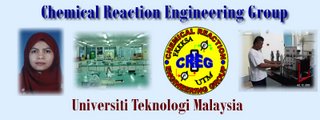 This is the continuity of the previous posts...
This is the continuity of the previous posts...
> Do research on the subject that you study in. Get technical papers from internet......(check out the previous posts....)
> Create / build your experimental rig .....This is quite fun....especially if you're handy and creative...i constructed my own experimental rig which consists of a small 'carbolite' tubular furnace which has a maximum temperature of 900oC. Also i have 2 digital mass flow controler fixed as well on the rig. It's used to control the flow of CH4 and O2 in the 1/2" quartz reactor.
> Synthesize catalysts.....it took me 7-8 days to synthesize 1-2 grams of catalysts !!!! Characterize catalysts.....Using:
X-Ray Diffraction (XRD) : to study the crystalinity of the zeolite. We will know what type of zeolite it will belong.
Scanning Electron Microscopy (SEM) : to study the surface morphology of the zeolite catalyst.
Fourier Transform Infra Red (FTIR) : to study what type of chemical bonding is available in the zeolite catalyst.
Temperature Program Desorption (TPD) : to study the active acid sites on the zeolite catalyst
Atomic Adsorption Spectroscopy (AAS) : to study the composition of metals available in the zeolite catalyst
> Run experiment at your rig .... I did experienced runing my experiment 24 hours ....normally it took 8 hours to run one experiment. After arranging the experiment according to design of experiment (DOE) using the response surface methodology (RSM), i have an arrangement of different flowrate of gases to control, different mass of zeolite catalyst and also different operating temperature.
> Publish technical papers, technical posters ....ooo i love this part.....I published several technical papers in various local conferences and one conference in Indonesia. I have one paper published in a refereed journal as well. hu hu....Thanks to my supervisor who always encourage all of us to do technical writing. This palys a major part if anyone want to pass their post graduate study easily....
> Participate in technical exhibitions in and outside the country....depending on your budget....Well i went to some local exhibitions. It's great to be out there. We are exposed to tonnes of other research activities. Besides exhibiting, it's also a contest and our research group won several times...!!! hu hu....
> Present technical papers, technical posters ......i enjoyed this one too....When i attend some technical conferences, i presented my technical papers to related fellow researches from the same field. We exchange ideas and discuss various things. The location of the conference will always be in a 5 start hotel...which means the food is great!!! hu hu....
> Guide/supervise your juniors if there is....They can help you do some stuff too....from this we have some "human resource"...they can help us a little bit....and at the same time we guide them doing the research work. It's a actually a synergy process...
> When for some technical visit....This is fun too, you get to travel and learn...we went to few research center to coorporate and learn more and do some joint venture....this is great too....we can see some other research centre which are more establish and have better research facilities.
> Undergo your first stage post graduate proposal......Hopefully i pass this one...and yes, i passed...with some minor modifications on the research methodology.
> Prepare for your VIVA - Final exam. This is where you defend your research ....the terrfying moment..... and i can remember how sweat i was that time. I was very nervous ...but Thank God i passed the VIVA....
Check out >>> Chemical Reaction Engineering Group Website HERE
posted by Kipas Repair JB @ 11:25 PM,
,
![]()
Chemical Engineering Career You Can Expect...It's Your Choice...Part 2
1. Research & Development / Post Graduate Study in a University....
This is the first thing i did after graduating. I became a research assistant under a very succesful profesor (Prof. Dr. Nor Aishah Saidina Amin) specializing in Raction Engineering/Catalysis. The research group was called: "Chemical Reaction Engineering Group" or CREG. CREG is based in Faculty of Chemical and Natural Resources Engineering, Universiti Teknologi Malaysia.
When i first started, the group consists of 2 pH.D students and 2 masters student besides several first degree student doing research related to Natural gas to gasoline conversion and also palm oil to gasoline conversion using zeolite ZSM-5 catalysts. Well, as i mention to you guys earlier, i don't really know what are the jobs nature for a chemical engineer, and it includes the job as a research assistant. Well, in general i know a research assistant will assist in doing some research. But, as days go by, i deeply understand the nature of research work. Well, after about 6 months, i continued with my full time research Masters in Chemical Engineering.
Let me tell you what research people do in general.....point by point....not in particular order.....
(my point is totally based on my experience....it maybe partially useful for anyone who wants to do reseach, and can be very useful if you want to do research relating to catalysis and reaction engineering)
> Do research on the subject that you study in. Get technical papers from internet and library and other sources available at your university. One of the place where i get my technical papers >>>> www.sciencedirect.com
Some, of them i got it from the library in my uni. Some of them, i have to go to National University of Singapore to get more technical books and references.....Well, i have a mass collection of this technical papers and books....I have both hard copy and soft copy....hu hu....
> Create / build your experimental rig .....This is quite fun....especially if you're handy and creative...
> Synthesize catalysts.....it took me 7-8 days to synthesize 1-2 grams of catalysts !!!!
> Characterize catalysts.....Using XRD, SEM, FTIR, TPD etc.......
> Run experiment at your rig .... I did experienced runing my experiment 24 hours .....
> Publish technical papers, technical posters ....ooo i love this part.....
> Participate in technical exhibitions in and outside the country....depending on your budget....
> Present technical papers, technical posters ......i enjoyed this one too....
> Guide/supervise your juniors if there is....They can help you do some stuff too....
> When for some technical visit....This is fun too, you get to travel and learn...
> Undergo your first stage post graduate proposal......Hopefully i pass this one....
> Prepare for your VIVA - Final exam. This is where you defend your research ....the terrfying moment.....
I'll elaborate about the points in 1-2 days time....ok....
posted by Kipas Repair JB @ 8:13 PM,
,
![]()
Chemical Engineering Career You Can Expect...It's Your Choice...Part 1
When i was doing my chemical engineering degree, well most of us know that we are going to be a chemical engineer after graduating. For me, I don't really want to be a chemical engineer. Instead i would prefer be a chemical engineering lecturer. This is simply because i know the lifestyle of a lecturer because my father is a organic chemistry lecturer in Universiti Teknologi Malaysia. Most of my friends however, just want to be a chemical engineer.
That time, we don't really know in detail what does a chemical engineer do? If we know....perhaps we know very vaguely. Unless you'v been to a industrial or practical training in the industry for a semester or more, then you'll know what I'm actually saying. At least those students who've been in a practical/industrial training is very lucky to have the glimps and exposure of the chalenging industry.
As i mentioned in my earlier post, i've been in the chemical engineering reseach field, oil & gas/service engineer field and also plant/refinery field. I feel very lucky and bless that i can taste various types of chemical engineering sector. LEt me just brief a little bit about all those different sectors......Some might agree, some might feel....is that all.....some might, i hope possibly get some valuable information from it.....
1. Research & Development / Post Graduate Study in a University.
This is the first thing i did after graduating. I became a research assistant for a very succesful profesor specializing in Raction Engineering/Catalysis. We have to do research work relating to the subject that we are researching. We have to do some labscale and also some pilot scale reasearch. I also enjoyed paper publication/technical paper writing... Not to mention going to exhibition, competing and wining great research awards locally and internationally. I also did some technical paper presentation in conferences. Also some technical poster publication....
[It will take a longer space for me to tell everything about this....i'll post the continuity of this story in 1 or 2 days time.....]
2. Service Engineer in an Oil & Gas field
After completing my masters degree, i was offered a job as a chemical application specialist/chemical technologist. But i call my self a chemical engineer...hu.. hu....This category of work is full of fun because i travel a lot (If you like travelling, you'll like this one...) I work on-shore and off-shore......hu hu...it's fun....One think that i cannot forget is watching "KILL BILL" in the Dulang Oil Platform, in Offshore Trengganu....
[It will take a longer space for me to tell everything about this....i'll post the continuity of this story in 1 or 2 days time.....]
3. Process Engineer in a Refinery
It was very unfortunate that i cannot continue working in the oil and gas servicing company longer. The management made a decision to move to KL to get better business chances...I got myself a job as a process engineer in a factory/plant processing edible oil. This is another chapter of a very very challenging work. Here, i practiced most of my unit operation knowledge. There's one very great huge secret of successfully surviving in this type of working area.....
[It will take a longer space for me to tell everything about this....i'll post the continuity of this story in 1 or 2 days time.....]
posted by Kipas Repair JB @ 1:51 PM,
,
![]()
The Author
I’m Zaki. I used to be a project, process and chemical engineer. Few years ago I successfully became a Chartered Engineer (IChemE) and Professional Engineer (BEM). I'm now employed as a chemical engineering educator/researcher/consultant. Hope you like reading my blog. I welcome any feedback from you. My email: zaki.yz[alias]gmail.com. TQ!


